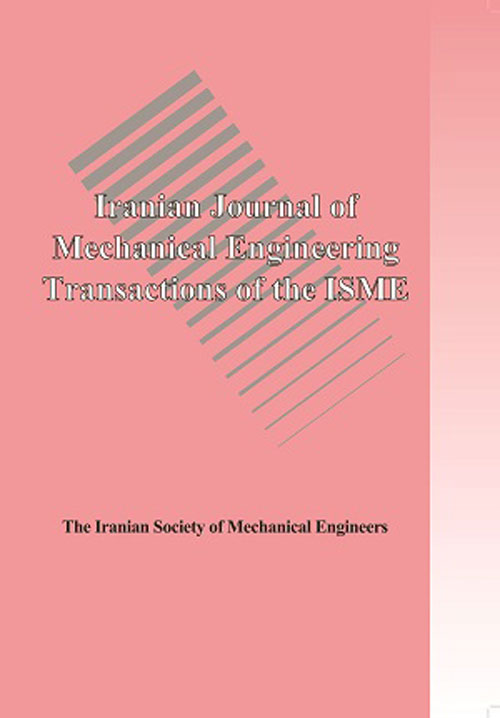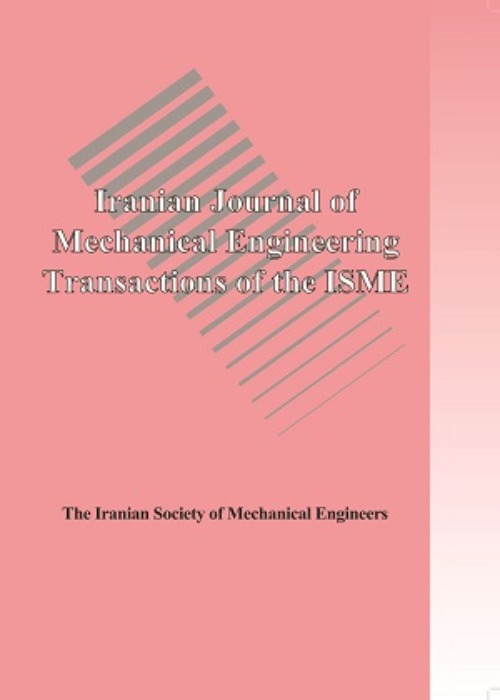فهرست مطالب

Iranian Journal of Mechanical Engineering Transactions of ISME
Volume:22 Issue: 2, Sep 2021
- تاریخ انتشار: 1401/03/07
- تعداد عناوین: 7
-
-
Pages 5-20In this paper, mechanical behaviour and buckling analysis of human femoral bone are performed using the finite element method. A method is proposed to model the geometry and mechanical properties of Femur specimens. Mechanical properties of the bone are regarded both as homogeneous and nonhomogeneous quantities. Compressive tests are performed in three regions of the midshaft to validate the mechanical properties obtained by the CT scan. Waterjet cutting method is used to cut the samples which are used in compressive tests, and the 3D-printed models are used to locate the samples between the jaws of the test machine. Critical axial buckling loads of the femurs are studied, applying both of the homogeneous and nonhomogeneous material properties. Results show that the buckling load which is obtained by proposed homogenous modeling technique is close to the one which is obtained by nonhomogeneous modeling, and the proposed method is quite capable to simplify the FE analysis of the diaphyseal cortical bone.Keywords: Diaphysis of Femur, finite element method, Buckling analysis, Compressive test, Computed tomography scan, DXA, Nonhomogeneous modeling
-
Pages 21-37Acoustic scaling is one of the efficient techniques for measuring acousticparameters of large and luxury places. Due to the range of acousticscaling frequency, an airborne ultrasonic transducer has been used fortransporting the power to the air. One major problem of ultrasonictransducers, radiating acoustic energy into the air, is to find the properacoustic impedance of one or more matching layers. This work aims atdeveloping an original solution to the acoustic impedance mismatchbetween transducer and air. Therefore we consider three piezoelectrics,PZT, PVDF, and EMFi transducers and air that have high acousticimpedance deference. We proposed the use of a genetic algorithm (GA) toselect the best acoustic impedances for matching layers from the materialdatabase for a narrow band ultrasonic transducer that works at afrequency below the 1MHz by considering attenuation. This yields ahighly more efficient transmission coefficient. Also, the results showedthat by using the increasing number of layers we can increase our chanceto find the best sets of materials with valuable both in acoustic impedanceand low attenuation. Precisely, the transmission coefficient is almosthigher than 80% for the more studied cases.Keywords: acoustic impedance, matching layers, Ultrasonic transducers, Genetic algorithm (GA), PZT, PVDF, EMFi
-
Pages 38-53FD-CVC (Feature Detection-Compressible Vorticity Confinement)methods were introduced by the authors in the past [1] and its resultfor some simple problems was investigated. In the present study, FDCVCmethods are used to study vortex flows around bluff bodies such asprojectile and square cylinder. The ability and flexibility of the methodsin more complex and applied problems are studied in this paper. It isobserved that using the FD-CVC methods, by limiting the effect ofvorticity confinement to the points needed, improve the results. It is seenthe proper functioning of these methods on various confinementparameters (using threshold function) shows the superiority of thepresent method over the standard CVC method.Keywords: Threshold Function, Confinement Parameter, Vortex Flows, Feature Detection Method, Compressible Vorticity Confinement
-
Pages 54-70Three methods for prediction of lean blowout in a turbine engine hasbeen introduced. The first method is a Hybrid Simulation-Test (HST),the second is a Hybrid Simulation-Semi empirical correlation (HSS)and the third one is based on Lefebvre’s Semi-Empirical Correlation(LSC). Before this research, calculation of parameters is done onlybased on fuel species transport without taking evaporation and/oratomization into account. This issue reduces actual amount of flamevolume. The values of 𝑞𝐿𝐵𝑂 (overall fuel-air ratio at lean blow out)predicted by HST, HSS and LSC were compared to experimentalresults. The error of (HST-FM & SM) method was 11.48 and 1.86percent and (HSS-FM & SM) method was 6.15 and 2.2 percent and(LSC) was 46.73 percent.Keywords: LBO PREDICTION, CFD, SPECIES TRANSPORT, Evaporation, atomization
-
Pages 71-87The present experimental study was done aimed to investigate dynamic ofa single bubble rising through wall-bounded flow at high Reynoldsnumber. Thus, Rhamnolipid biosurfactant was added to stagnant fluid andbubble diameter was controlled between 2.5 and 3.5mm. The resultedReynolds number was in the range of 400 to 900 depends on biosurfactantconcentration. Rhamnolipid has a low toxicity, a high biodegradabilityand good stability at a wide range of temperatures. The results showedthat terminal velocity linearly depends on Reynolds number. Furthermore,drag coefficient is related to Eötvos number and is autonomous toReynolds number. Finally, to estimate terminal velocity and dragcoefficient, four empirical correlations were developed. Relative errors ofthe proposed correlations were less than of 3.35% and 1.97% for velocityand dimensionless velocity equations, respectively, and average errors oftwo equations proposed for drag coefficient were 4.44% and 3.26%.Keywords: High Reynolds Number, Rhamnolipid biosurfactant, Terminal velocity, Drag coefficient, Wall-bounded flow
-
Pages 88-105In this paper, a gadget for controlling an electric wheelchair (EWC) is designed.The device is designed based on the combination of acceleration sensor data fromhead rotation, and image processing data from user’s face recognition, forcommanding to the EWC. This gadget designed as a wearable device and isdeveloped low cost, safe, and flexible for the patients with spinal cord injuries aswell as the elderly with limited hand use. The mechanical design, sensor tuning,and 3Dprinted prototype of the gadget are presented. Finally the result ofexperimental test is discussed. Acceleration sensor module and camera andRaspberry Pi board are the core of the gadget. For performance evaluation,several experiments have been performed. The commands sent by the user aredivided into four control commands (right, stop, move, left). Forward movementcommand, is performed by showing a happy expression on the face. Theexperiments show that the head angle controller and the image processor reactto the stop in the shortest time, which indicates that it has a high level of safety.Keywords: assistive robot, electric wheelchair (EWC), wearable gadget, image processing, acceleration sensor
-
Pages 106-115In this work, the thermal performance of CNT/water nanofluid for the heatexchanger with helical triple tubes is investigated experimentally. Thegeometry of the tube, the volume percentage of nanoparticles,and Reynolds number are three key characteristics investigated. Twocases with different curvature ratios of 0.010 and 0.0167 are constructedand compared to investigate the impact of the curvature ratio onconvection heat transfer. The results show that the Nusselt number ofnanofluids is larger than the base fluid. In addition, maximum andminimum values of Nusselt number are found for Reynolds numbers of1000 and 5000 correspondingly. The results show a slight reduction inpressure drop for pure water as the Dean number increased. Moreover,while the volume fraction of nanoparticles less than 0.1%, the Nusseltnumber increased with a shallow slope.Keywords: helical triple tube, Heat Transfer, nanofluid, Carbon Nanotube


